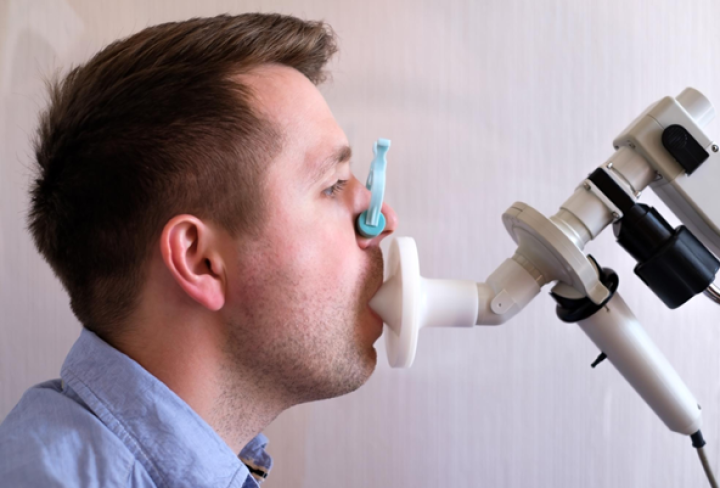Respiratory issues like asthma, COPD, and chronic bronchitis can disrupt the vital process of breathing. Pulmonary Function Tests (PFTs), particularly spirometry, are essential diagnostic tools that provide a comprehensive look into your lung health. Whether you’re experiencing symptoms like shortness of breath or managing a chronic condition, spirometry offers clarity and direction for effective treatment.
This blog explores what spirometry entails, its benefits, and why it’s a cornerstone of respiratory care.
What is Spirometry?
Spirometry is a simple, non-invasive test that measures how well your lungs work by evaluating the air you inhale and exhale. It’s commonly used to detect, diagnose, and monitor respiratory conditions. By understanding your lung function, doctors can recommend the right treatments or lifestyle adjustments to improve your quality of life.
Why Spirometry is Important
Spirometry isn’t just for diagnosing respiratory problems—it plays a vital role in ongoing care and prevention. Here’s why it’s crucial:
- Early Detection: Identifies lung diseases like asthma or COPD before they become severe.
- Treatment Monitoring: Assesses how well medications or therapies are working.
- Pre-Surgical Evaluation: Ensures your lungs are strong enough for certain procedures.
- Preventive Health: Tracks changes in lung function for high-risk individuals, such as smokers or those with occupational exposures.
How Spirometry Works
The spirometry test is straightforward and typically completed in under 30 minutes. Here’s what to expect:
- Consultation: Your doctor will discuss your medical history, symptoms, and any medications you’re taking. This helps tailor the test to your needs.
- Preparation: You’ll sit in a comfortable position and wear a nose clip to ensure all airflow is measured through your mouth.
- Breathing Test: You’ll place your lips around a mouthpiece connected to the spirometer. The technician will guide you to:
- Inhale deeply.
- Exhale forcefully and as completely as possible.
- The process may be repeated several times to ensure accurate results.
- Post-Test Review: Once the test is complete, your doctor will analyze the results and explain what they mean for your lung health.
Understanding Spirometry Results
The spirometer provides several key measurements, including:
- Forced Vital Capacity (FVC): The total amount of air you can exhale after a deep breath. A reduced FVC may indicate restrictive lung disease.
- Forced Expiratory Volume in 1 Second (FEV1): The volume of air exhaled in the first second. A low FEV1 suggests obstructive conditions like asthma or COPD.
- FEV1/FVC Ratio: This ratio helps differentiate between obstructive and restrictive lung diseases.
Who Should Take a Spirometry Test?
You may need spirometry if you experience any of the following symptoms or conditions:
- Persistent coughing or wheezing
- Shortness of breath
- Chest tightness
- Fatigue during physical activity
- Family history of respiratory diseases
- History of smoking or exposure to environmental pollutants
Spirometry is also recommended for those undergoing treatment for asthma or COPD to monitor progress and adjust therapy as needed.
Benefits of Spirometry
Spirometry offers numerous advantages for patients and healthcare providers alike:
- Non-Invasive and Safe: The test is quick, painless, and poses no significant risks.
- Accurate Diagnosis: Helps identify specific respiratory conditions and their severity.
- Improved Treatment Plans: Provides data to customize medication and therapy.
- Proactive Care: Tracks changes in lung function over time, ensuring early intervention if problems arise.
Common Respiratory Conditions Diagnosed with Spirometry
- Asthma: Identifies reversible airway obstruction and measures the effectiveness of bronchodilators.
- Chronic Obstructive Pulmonary Disease (COPD): Assesses airflow limitation and progression of the disease.
- Pulmonary Fibrosis: Detects reduced lung capacity due to scarring or stiffness.
- Bronchitis: Helps evaluate inflammation-related breathing issues.
How to Prepare for a Spirometry Test
Preparation is key to getting accurate results. Here are some tips:
- Avoid heavy meals, smoking, or caffeine before the test.
- Wear loose, comfortable clothing that doesn’t restrict your breathing.
- Follow your doctor’s instructions about withholding certain medications.
- Inform your doctor of any recent respiratory infections or illnesses.
What Happens After the Test?
After your spirometry test, your doctor will review the results and discuss the next steps. If abnormalities are detected, further tests or treatments may be recommended. In some cases, lifestyle changes like quitting smoking, improving diet, or incorporating regular exercise can significantly improve lung function.
When to Seek Medical Advice
You should consult your doctor if you notice:
- Persistent or worsening shortness of breath
- Difficulty performing everyday tasks due to fatigue
- Chronic cough that doesn’t improve with treatment
- Family history of respiratory diseases
Spirometry can provide the answers you need to address these concerns effectively.
Why Choose Pulmonary Function Testing at Our Facility?
Our advanced diagnostic center offers state-of-the-art spirometry and pulmonary function testing services. With skilled technicians and personalized care, we ensure accurate results and a comfortable testing experience. Whether you’re seeking diagnosis, monitoring, or preventive care, we’re here to support your journey toward better respiratory health.
Take Charge of Your Lung Health Today!
Don’t let respiratory issues hold you back. Schedule your spirometry test now and breathe easier with expert guidance and advanced diagnostics. Prioritize your lung health today—contact us to book your appointment!



